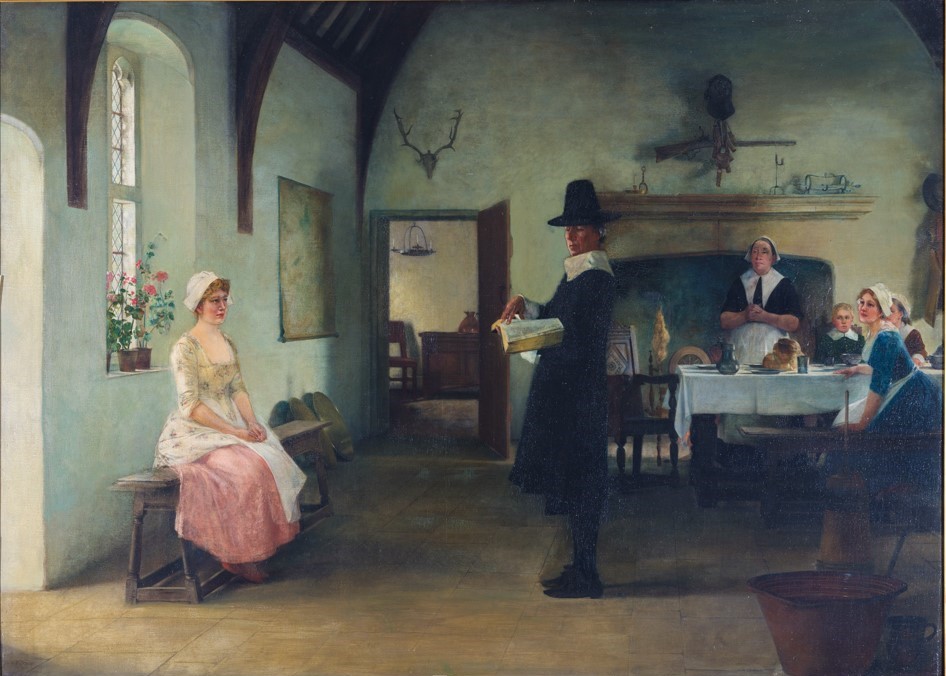
Black Sheep
Date: circa 1900
Dimensions: Height: 88.9 cm (35 in.), Width: 124.46 cm (49 in.)
Medium: Painting – oil on canvas, mounted on Aluminum 1964
Owner/Location: New Bedford Free Public Library purchased from the estate of Frank D. Millet,1912
Painting illustrated here is courtesy of the New Bedford Free Public Library.
Description
The Black Sheep is an interior scene in the style of Millet’s “Colonial” paintings showing a family in their dining room. The center of the canvas is dominated by a man in Puritan dress standing holding a bible, from which he appears to be reading aloud. A dark shadow surrounds the man and extends to the right, into the center of the painting, onto the fireplace mantle, and up the wall toward the top of the painting passing over the items above the mantle, ending just prior to the face of the mother figure.
On the right of the canvas are four figures representing the majority of the family unit, the mother stands with hands clasped in front of the hearth, and a young boy and teenage girls sit at the table. All of these figures are dressed modestly, in solid colors, and all of their gazes are fixed on the final figure in the painting.
On the left, a young woman sits with her hands in her lap wearing a floral patterned, square necked dress and bright pink skirt, and although her blond hair is covered by a cap, she is not wearing a fichu, leaving her shoulders and neckline exposed. The young woman appears to be blushing as she listens to her father’s sermon. This composition sets the young girl in pink apart as the black sheep of her family, though Millet has painted her very sympathetically, with light from the window and doorway behind her to illuminate her, and several potted flowers in bloom on the sill to her left to mirror the pink of her dress.
This painting was clearly done in the Broadway, England, studio known as The Grange; as were several of the other colonial genre paintings, such as Between Two Fires. The fireplace itself and the beamed ceiling are well recognized in other Millet paintings. The Grange can be visited today in Broadway, where it is functioning as a hotel. Other commonly used items by Millet are also visible, such as the two candle stick holders on the mantle, the map on the wall, which takes on different geography depending upon the Millet painting in which it is used, however the roller bars are commonly painted the same in each Millet painting. Also through the door hangs a chandelier also seen in other works. On the floor below the map are two wide mouth basins and even the bench on which the young lady sits is commonly used by Millet in his colonial works.
Sitting upon the window sill behind the woman is what may be interpreted as a pink Geranium, painted in the colors of the woman’s face and dress. It is interesting to note here that the meaning of the Geranium has commonly been held to represent many desirable attributes of love, peace, healing, elegance and spirituality, however in Victorian times the flower was associated negatively to symbolize envy, deceit and folly. Most of these negative connotations were attributed to the geranium mainly throughout the Victorian era because the geranium flowers have a simple and light appearance, they also became a symbol of foolishness and stupidity.
Millet often left the interpretation of his paintings more open or fluid. Particularly in his colonial paintings, he was willing to let the viewer carry their own life experiences and interpretations into the works.
Exhibitions / Provenance
Exhibitions:
1912, Metropolitan Museum, New York, 1912
1964, Hutchinson’s or Saltmarsh’s bookstore centennial week celebration, New Bedford, MA, June 13-20, 1964.
1999, The Easel Paintings of Francis Davis Millet, Guild of Boston Artists, April 6-24, 1999.
Provenance:
New Bedford Free Public Library purchased The Black Sheep from the estate of Frank D. Millet,1912
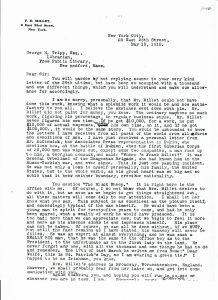
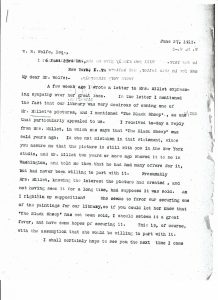
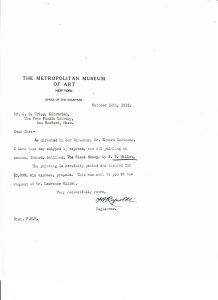
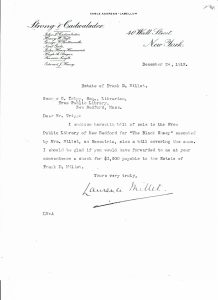
Literature
Research:
In 1910, The New Bedford Free Public Library completed the renovation of their new library building in what used to be City Hall, the same building that houses the library today. In celebration of the new building, the library’s director George H. Tripp and the Board of Trustees contracted Francis D. Millet to create a series of murals depicting the history of the whaling industry. Tripp made several visits to Millet’s studio and in turn Millet came to view the library building in preparation for these murals.
Millet’s busy schedule drew out the process, but by 1912, he was ready to begin his final sketches of the murals for approval by the board. According to the last letter Millet sent to Tripp Feb 10, 1912 he was on his way to Rome and would begin “to worry about the job in detail.” After Millet’s death aboard the Titanic and the demise of the mural project and any sketches Millet might have prepared, Tripp sent his condolences to Mrs. Francis Millet and inquired after the possibility of purchasing one of the artist’s easel paintings. After some back and forth between Tripp, Mrs. Millet, Lawrence Millet, and W.R. Wolfe, Millet’s private secretary, it was decided that the library would purchase The Black Sheep for $3,000.
Tripp had admired the painting during his visit to Millet’s studio, and according to him, Millet had said that the painting was a personal favorite and that though he had had several offers for it he had been able to part with it during his lifetime.
Publications:
Reproduced in: Artists of New Bedford, Blasdale, 1990
